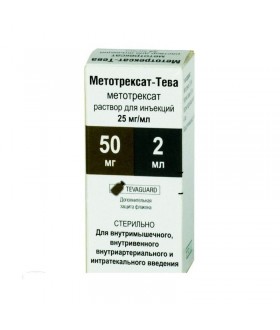




Security policy (edit with Customer reassurance module)

Delivery policy (edit with Customer reassurance module)

Return policy (edit with Customer reassurance module)
Pharmachologic effect.
An antitumor agent from the group of folic acid antagonist antimetabolites. Acts in the S-phase of mitosis. The mechanism of action is associated with the inhibition of the synthesis of purine nucleotides and thymidylate as a result of irreversible binding to dihydrofolate reductase, which prevents the recovery of dihydrofolate to active tetrahydrofolate. More active against fast growing cells. It has some immunosuppressive effects.
Pharmacokinetics.
To a small extent penetrates through the BBB (depending on the dose used). When intrathecal injection in a significant amount enters the systemic circulation. Protein binding (mainly albumin) of plasma is about 50%. Biotransforming in the liver. Excreted by the kidneys (unchanged) and with bile (less than 10%). The half-life depends on the applied dose and has significant individual differences. When reintroduced accumulates in the tissues in the form of metabolites.
Indications.
Acute lymphocytic leukemia, trophoblastic disease, skin cancer, cervical and vulvar cancer, esophagus cancer, head and neck squamous cell carcinoma, renal pelvis and ureter cancer, osteogenic and soft cell sarcoma, Ewing's sarcoma, lung cancer, breast cancer, germ cell tumors of the testicle and ovarian, liver cancer, kidney cancer, retinoblastoma, medulloblastoma, penile cancer, lymphogranulomatosis. Severe forms of psoriasis (in case of failure of adequate therapy). Severe rheumatoid arthritis (in case of failure of adequate therapy).
Dosing regimen.
Appoint inside, in / in, in / m, intralyumbalno. The regimen of Chemotherapy is set individually, depending on the patient's condition, the effectiveness and severity of the toxic effects of therapy. In lymphoblastic leukemia, the initial dose by mouth is 3.9 mg / m2 per day as part of a combination therapy. Maintenance dose of 30 mg / m2 per week.
For children, the average dose for tumor diseases is 20-40 mg / m2 1 time per week.
In psoriasis, Methotrexate is used in lower doses and is prescribed by mouth, im, or iv. The maximum weekly dose is 30 mg. The duration of treatment is determined individually.After reaching the optimal therapeutic effect, the dose should be reduced to the minimum effective.
In rheumatoid arthritis, the maximum weekly dose is 20 mg.
Side effect.
On the part of the digestive system: possible ulcerative stomatitis, anorexia, gingivitis, pharyngitis, nausea; rarely - diarrhea, melena, enteritis, pancreatitis; in some cases (with prolonged daily use) - liver necrosis, cirrhosis, fatty atrophy, periportal fibrosis of the liver.
On the part of the blood system: leukopenia, anemia, thrombocytopenia.
From the side of the central nervous system: feeling tired, dizzy; rarely - headache, aphasia, drowsiness, cramps.
Reproductive system: disorders of oogenesis and spermatogenesis, oligospermia, menstrual disorders, decreased libido, impotence.
On the part of the urinary system: hematuria, cystitis, pronounced renal dysfunction.
Allergic reactions: chills, reduced resistance to infection; rarely - urticaria, toxic epidermal necrolysis, Stevens-Johnson syndrome.
Dermatological reactions: skin rash, photosensitivity, pigmentation disorders, telangiectasia, acne, furunculosis.
Contraindications.
Severe disorders of the liver and / or kidneys, leukopenia, thrombocytopenia, pregnancy. Methotrexate should not be used in immunodeficiency states.
Pregnancy and lactation.
Methotrexate is contraindicated for use in pregnancy. If necessary, appointments during lactation should stop breastfeeding.
Women of childbearing age should use reliable methods of contraception during the use of methotrexate.
In experimental studies, the embryotoxic and teratogenic effects of methotrexate have been established.
Special instructions.
Methotrexate should not be used for ascites, pleural effusion, gastric ulcer and duodenal ulcer, ulcerative colitis, gout or nephropathy (including in history).
It is not recommended for use in patients with chickenpox (including recently suffered or after contact with the sick), herpes zoster and other acute infectious diseases.
Before starting therapy and on the background of the treatment, a picture of peripheral blood, liver and kidney function, and chest X-ray should be monitored.
When treating rheumatoid arthritis or psoriasis, a complete complete blood count should be done at least once a month, and laboratory tests of liver or kidney function at least once every 1-2 months.
When applied for psoriasis, local treatment of the disease should not be interrupted. In case of overdose, the use of Calcium folinate is recommended (but no later than after 4 hours).
When conducting a combination of anticancer therapy, special care should be taken when simultaneously administering high doses of methotrexate with drugs that have a nephrotoxic effect (for example, cisplatin).
Do not recommend vaccinating patients and their families.
Caution should be used to combine methotrexate (even in low doses) with Acetylsalicylic acid.
In experimental studies, the carcinogenic and mutagenic effects of methotrexate have been established.
Methotrexate in the form of tablets, powder for injection and solution for injection is included in the List of Vital and Essential Drugs.
Drug interaction.
With simultaneous use of methotrexate (even in low doses) with penicillins, the toxic effects of methotrexate may be enhanced.
The simultaneous use of methotrexate and co-trimaxosol can lead to increased myelodepressive action.
At simultaneous use with the vitamin preparations containing folic acid or its derivatives, decrease in efficiency of a methotrexate is possible.
The simultaneous use of methotrexate and NSAIDs in high doses can lead to an increase in plasma concentration of methotrexate and to a prolongation of its elimination period, as well as to an increase in the concentration of methotrexate not associated with plasma albumin, which in turn enhances the toxic effects of methotrexate (primarily on the gastrointestinal tract and hematopoietic system).
The simultaneous use of methotrexate with probenecid can lead to a decrease in the excretion of methotrexate by the kidneys (requires careful medical monitoring).
With simultaneous use of tetracyclines, chloramphenicol and some other broad-spectrum antibiotics taken orally can reduce the absorption of methotrexate from the gastrointestinal tract or interfere with the process of hepato-intestinal recycling.
Terms and conditions of storage.
To store a preparation in the place protected from light, at a temperature not above 25 ° C. Keep out of the reach of children.
Shelf life - 3 years. Do not use after the expiration date printed on the package.